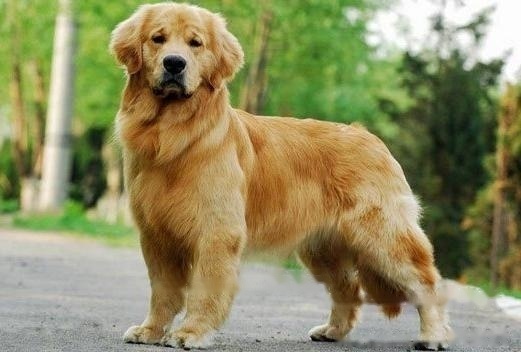
Golden Retriever's FCI number: 111
Golden Retriever's FCI Group: Group 8: Retriever, Search Dogs and Water Spaniels
Golden Retriever Height: Male Golden Retriever 22.1-24.0 inches (56.0-61.0 cm) at shoulder, female Golden Retriever 20.1-22.1 inches (51.0-56.0 cm) at shoulder
Golden Retriever Weight Range: Male Golden Retriever 59.5-79.4 lb (27.0-36.0 kg) Female Golden Retriever 55.1-70.6 lb (25.0-32.0 kg)
Golden Retriever head (head, face) , eyes, ears, nose, mouth, muzzle, jaw, teeth)
Head: The brows are well-defined, the head cover is broad, and the head cover is connected to the nose and mouth. Nose: Black or brownish-black, may be lighter in colder climates. The distance between the eyes is wide. Eyes: Dark brown, dark and bright, well spaced, moderately sunken, medium in size, hanging over the eyes and set close to the cheeks. Ears: Short, with the leading edge set back, just above the eyes, drooping and close to the cheeks. If pulled forward, the tips of the ears just cover the eyes. Jaws/Teeth: The jaws are strong in a scissors bite, with the inner sides of the upper incisors touching the lower incisors. That is, the upper teeth are pressed against the lower teeth, forming a square with the lower jaw. Muzzle: Strong, broad and deep. The length of the front face is approximately equal to the length from the toes to the occiput.
Golden Retriever's torso (neck, chest, ribs, waist and back, front of torso, skin)
Neck: The neck is of medium length and appears Strong and muscular. Throat skin should not be too loose and sagging. Topline: Strong, level from withers to slightly sloping croup, at rest and in motion. A sloping, arched, concave back; flat or too steep hips are faults. Chest: Deep chest. The chest width between the legs is at least equal to the width of the closed hand (including the thumb) of an adult man, and the chest is well developed. The sternum extends to the elbow. Ribs long and well-curved, but not barrel-shaped, extending well into the hindquarters. Loin: Short, strong, broad and deep, with slight contraction in the loin when viewed from the side. Flat sides, narrow chest, insufficient chest depth, and excessive waist contraction are defects.
Golden Retriever's limbs (forehead, shoulders, upper limbs, pelvic joints, pelvis, soles, hindquarters, thighs, hocks, joints and hock nails)
Forequarters: Strong, well-coordinated with hindquarters, free to move. The shoulder blades are long and well set back, with the tips abutting at the withers. The upper arm is about the same length as the shoulder blade; the back of the elbow is just below the tip of the shoulder blade, snug against the ribs, without slack. From the front, the legs are straight and well-boned, but not stout. The palms are short and strong, slightly sloping, showing no signs of unsteady support. Pseudotoes are removed, but usually retained. Hindquarters: Broad and well muscled. Viewed from the side, the hips are slightly sloping down; the pelvis is slightly more inclined (about 30 degrees from the horizontal). In the natural standing position, the thighbone is connected to the pelvis at about 90 degrees; the knee joint is fully bent; the heel joint is fully close to the ground, and the metatarsal bones are short and strong. The feet are similar to the front feet. Seen from behind, the legs are straight. Heel inversion, heel valgus, and heel extension are all defects. Feet: Of medium size, round and compact, with well-knuckles and thick toe pads. Excessive hair should be trimmed to reveal its natural size and contours. Shoulders: The shoulders are set back and the shoulder blades are long. Upper Arm: As long as the shoulder blades, well supported on the legs. Elbows: Closely engaged. Hocks: Viewed from behind, naturally relaxed and straight, neither in nor out. Bull-shaped hocks are highly undesirable.
Golden Retriever's Tail
Tail: Tail high at the base, thick at the base of the tail, well muscled, extending naturally to the rump line. The coccyx extends to (but not below the heel joint). Tail raised cheerfully in a level or moderate upward curve; not curled over the back or tucked between the legs.
Golden Retriever's gait/movement
At trot, the gait is free, fluid, powerful, coordinated, with a full stride. From any angle, the legs neither turn in nor out, and the feet do not entangle or cross each other. As speed increases, the foot tends to converge on the central balance line. It is recommended that the leash is relaxed to show a natural gait.
Disqualifications for Golden Retrievers
Defects: Any deviation from the above points is considered a defect, and any apparent physical or behavioral disorder will be for disqualification. More than an inch below or above the standard height, with a prominent upper or lower jaw.
![[Dog Training 5] The training method of pet dog dining etiquette](/static/img/12192/12192_1.jpg)




